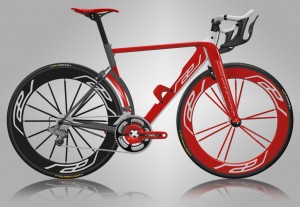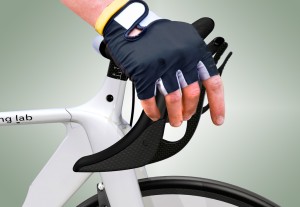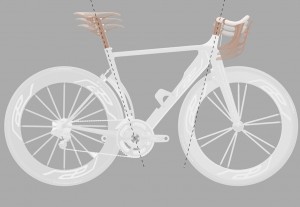 You may remember the Rael road bike concept by Evan Solida from a post earlier this year. Since that time, Evan has refined the design and set up a website for the project, which he hopes to move forward with soon.
You may remember the Rael road bike concept by Evan Solida from a post earlier this year. Since that time, Evan has refined the design and set up a website for the project, which he hopes to move forward with soon.
Evan’s primary focus lately has been the development of his Cerevelum “digital bike mirror”, but he developed the Rael as a side project in order to approach the design of a road bike as “a whole rather than a frame and components”. A few of the resulting details in his design are pretty interesting and challenge the conventional (UCI approved) way of constructing a racing bike.
 At first glance, the handlebars, with upside down brake levers, are probably the most noticeable difference between this concept and any other high-end road bike. Evan explains the reason for that ergonomic change; “Anyone that has descended a steep mountain knows that the most braking power comes from having hands in the drops, thus using the index finger to pull back the lever. While not the strongest digit, the index finger allows for the longest pulling distance and greatest modulation. By moving the pivot location for the brake to the bottom of the bars, the rider has increased modulation and power while riding on the top of the bars, much in the same location as the hoods are in modern-day systems.” He points out that, “with the advent of electronic shifting, no longer is the shape of the lever dictated by the actuation of the cables”, so a complete redesign of the cockpit area makes sense.
At first glance, the handlebars, with upside down brake levers, are probably the most noticeable difference between this concept and any other high-end road bike. Evan explains the reason for that ergonomic change; “Anyone that has descended a steep mountain knows that the most braking power comes from having hands in the drops, thus using the index finger to pull back the lever. While not the strongest digit, the index finger allows for the longest pulling distance and greatest modulation. By moving the pivot location for the brake to the bottom of the bars, the rider has increased modulation and power while riding on the top of the bars, much in the same location as the hoods are in modern-day systems.” He points out that, “with the advent of electronic shifting, no longer is the shape of the lever dictated by the actuation of the cables”, so a complete redesign of the cockpit area makes sense.
 You will also notice that the angle of the stem is quite different from a traditional road bike. Instead of adjusting the bars and stem up and down at an angle that is roughly parallel to the seat tube, this design allows the reach and height of the handlebars to “increase proportionally to that of the saddle height, making it easier for cyclists to find their ideal position.”
You will also notice that the angle of the stem is quite different from a traditional road bike. Instead of adjusting the bars and stem up and down at an angle that is roughly parallel to the seat tube, this design allows the reach and height of the handlebars to “increase proportionally to that of the saddle height, making it easier for cyclists to find their ideal position.”
 The carbon front triangle features an airfoil shaped downtube that “splits the air coming off the front wheel, then sends the “dirty” air back towards the convex seat-tube and fins. The arched, titanium fins located on either side of the triangular seat-tube are placed in such a way that they direct air inwards towards the seat-tube. The convex cross-section of the seat-tube then pushes the turbulant air away from the spinning rear-wheel.” It is an interesting approach to aerodynamics, and I would love to see how it works in a wind tunnel.
The carbon front triangle features an airfoil shaped downtube that “splits the air coming off the front wheel, then sends the “dirty” air back towards the convex seat-tube and fins. The arched, titanium fins located on either side of the triangular seat-tube are placed in such a way that they direct air inwards towards the seat-tube. The convex cross-section of the seat-tube then pushes the turbulant air away from the spinning rear-wheel.” It is an interesting approach to aerodynamics, and I would love to see how it works in a wind tunnel.
 The oversized bottom bracket shell is another noticeable detail. A two-piece crank bolts together in the middle of the shell and rolls on 40 roller bearings for a smooth spin.
The oversized bottom bracket shell is another noticeable detail. A two-piece crank bolts together in the middle of the shell and rolls on 40 roller bearings for a smooth spin.
I have just pointed out a few of the interesting design details here. There are several more that you can read about on the “details” page of the Rael website.
While I am posting about road racing bikes, I’ll mention this Bicycling Magazine photo feature of State-of-the-Art Bikes and Tech at the Tour de France. Several new 2012 bikes like the Cervelo S5, the Ridley Noah IBS, the Specialized Tarmac SL4, and the Giant TCR Advanced SL are shown. All are very nice, but the new Ridley, with integrated brakes and other ‘fast concept’ features is the new road bike that excites me the most. The Cervelo is the bike that seems to be getting the most media attention right now. That might have something to do with a certain Norwegian in yellow though, so expect the media focus to be on another bike soon…perhaps one from BMC.

Leave a Reply to station44025 Cancel reply